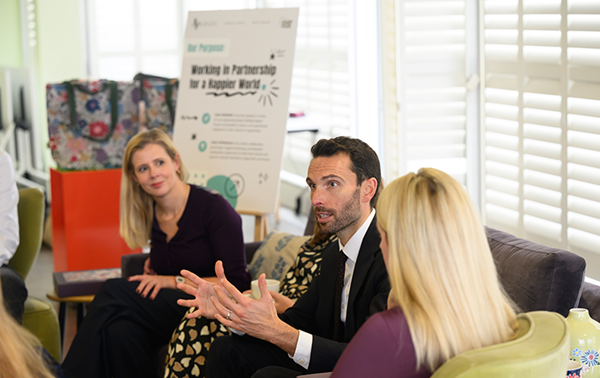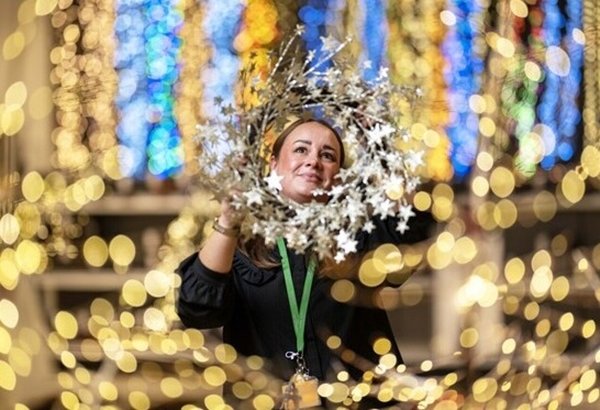- Four projects reveal their 12 month progress, helping to make menstrual cups mainstream, redesign children’s shoes to make them last longer, create ‘lend and mend’ hubs in libraries and technology to enable polyester to be recycled again and again.
- The £1 million fund was launched in November 2021, calling for new ideas and innovations to transition towards a more circular economy
- The Circular Future Fund was raised from the sales of 10p plastic bags
The John Lewis Partnership and environmental charity Hubbub, have today published an impact report, detailing the progress of four trailblazing projects that were awarded funding as part of the Circular Future Fund, created to find pioneering circular economy ideas.
In 2022, four projects were each awarded grants of between £150,000 - £300,000, from 245 applications, to develop their innovative solutions that challenged the ‘make…use…throw-away’ culture of modern society. The £1 million fund was made possible by the sales of 10p plastic bags through the John Lewis Partnership.
Helping menstrual cups go mainstream, redesigning children’s shoes to make them last longer, creating ‘lend and mend’ hubs in libraries and enabling polyester to be recycled again and again were the winning projects chosen by an independent Grant Fund panel of industry experts. Each winner was then supported by Hubbub to develop and achieve their ambitions.
The successful projects have each reported significant progress with proven results that leave a strong legacy for their respective industries. By sharing their learnings and challenges in the report, they hope to inspire others to follow in their footsteps towards creating a more circular economy.
Key outcomes from each project are detailed below:
DAME – Helping menstrual cups go mainstream
The perfect circular sustainable period product, the menstrual cup, has existed for decades, yet it remains a niche product that only 5% of people with periods use. DAME aimed to break down the barriers to using menstrual cups. They gained insight of the barriers to cup use, through surveys and a small user group trial, identifying the main concerns as comfort, leaking, and inserting a menstrual cup, plus cleaning it.
The difference made:
To help combat these barriers, the project created a myth-busting cup user guide, featuring Hayley Morris which is viewed 4,500 times per day.
DAME also designed a groundbreaking self-sanitising menstrual cup, removing the need to boil or sterilise cups. Launched in June, the self-sanitising period cup has achieved several ISO standards to prove its safety and effectiveness.
Each cup is predicted to contribute 99 times less carbon over its lifetime (compared to boiling a traditional cup) and avoids the need for 2,860 disposable period products per person over a lifetime of periods.
Next DAME are exploring charity partnerships to see if the cup could be available to those experiencing period poverty, and sharing the user guide content with educators to help more teenagers to try and stick with menstrual cups.
PIP & HENRY - Redesigning children’s shoes to make them last longer
Pip & Henry’s research and development project explored extending the life of children’s shoes. Young children replace shoes every 4 months, while 85% of shoes currently end up in landfill . Pip & Henry’s project aimed to explore two solutions to disrupt the children’s footwear industry.
The difference made:
Over the year period, Pip & Henry actually developed three concepts to work towards their vision of an expandable shoe and shoe that can be more cleanly separated into their component materials and therefore more easily recycled.
They hope to launch a capsule collection in 2024 and are exploring licensing concepts to help scale their circular shoe innovations.
The project has provided in-depth knowledge about the environmental impacts of footwear manufacturing methods and material innovations, plus how to design for better end of life recycling.
Pip & Henry plan to share their learnings and insights with the footwear manufacturing and recycling industries, to help create an industry step change to more circular shoe designs.
SCOTTISH LIBRARY AND INFORMATION COUNCIL (SLIC) – Establishing ‘lend and mend hubs’ in Scottish libraries
SLIC’s project aimed to create a network of lend and mend hubs across Scotland to support communities to repair, reuse, rent and upcycle everyday items.
The difference made:
Nine hubs have been created, with early indications suggest hubs have the potential to reach around 2,000 people per year through sewing and mending classes alone.
All libraries are offering equipment, workshops, and tools free of charge to overcome cost barriers for the public, making everyday circular economy actions more accessible.
The hubs are fitted out with circularity in mind, using repurposed office furniture saving 5 tCO2 compared to buying new and upcycled peg boards that were part of Kenya’s display at COP26 in Glasgow.
SLIC plan to create a toolkit, disseminated through workshops, to share their learnings and help other library services across the UK replicate their approach.
UNIVERSITY OF LEEDS - Innovating technology to enable polyester to be recycled again and again
Polyester is the world’s most common textile fibre and yet only 15% of polyester produced is made from recycled polyester (mostly from plastic bottles) . Currently there is no true circularity in the polyester industry because the dyes in polyester mean it cannot be easily removed which prevents it being recycled back into new virgin polyester fibre. The University of Leeds’s innovation created new novel ‘switchable-solubility’ dyes that enables them to be switched from water-soluble to water-insoluble to colour and de-colour polyester.
The difference made:
The research proves the dyes can be both added to, and removed from polyester, enabling the dye, water and fabric to be recycled with huge potential environmental benefits, needing less energy and water use, and removing the need for auxiliary chemicals in the dyeing process.
The introduction of the new CO₂ technology delivers a truly circular process that has the potential to recycle directly and mechanically some of the 57 million tonnes of polyester fibre produced globally each year.
The University of Leeds also made a bonus discovery, in that their technology also works on other fabrics such as denim and existing dyes in polyester.
Next the project plans to scale the technology to test at industrial scale, plus complete a full environmental lifecycle analysis.
The University of Leeds will share their discoveries with the textile and recycling sectors, plus exploring commercialising the technology to maximise its reach and impact.
Marija Rompani, Director of Ethics and Sustainability at the John Lewis Partnership said: “The Circular Future Fund allowed us to connect and support leading innovators to enhance their circular business models and drive the shift in circularity within the industry and society.
I'm so excited to share their findings, and hopefully this is just the beginning of the impact that each of the winning projects will have."
Saskia Restorick, Director at Hubbub said: “The four projects, while very different in nature, shared an ambition to bring innovative, creative and entrepreneurial approaches to designing out waste in their respective sectors. This forward-thinking fund, along with the winners’ hard work and dedication has enabled them to find tangible solutions and gain huge amounts of insight and knowledge. It has been a pleasure working with them and seeing their ideas come to life. We look forward to seeing how they develop and to sharing their successes to inspire even more innovation to speed up the transition to a more circular economy.”
The Circular Future Fund aimed to identify innovation and challenge the status quo, to boost the circular economy. The four projects have delivered on their ambitions, leave a strong legacy and offer tangible examples of the circular economy in action.
To find out more about the four projects, their impact and legacy, the Circular Future Fund impact report can be viewed at here.
Notes to Editors
Winners’ quotes
"As a small dynamic business with impact at its core, we're constantly looking at ways to push the boundaries of what's possible but often lack the resources. The grant has provided us with the bandwidth to innovate on product design and performance, and to spend time sourcing partners willing to switch up their current supply chains. In this way, we've been able to merge the dynamism of a small business with the clout of a larger business in order to drive real change in the category." – Alec Mills, Co-Founder, DAME
"As a young brand that genuinely wants to make footwear circular, we always had a strong vision for what we wanted to achieve. But this grant really propelled our ambitions, giving us the resources to get into the depths of material research, understand the complexities around the physics of what we would design, find ways to create operationally feasible solutions to the problem - all while keeping the customer at the heart of everything we've developed " Jeroo Doodhmal, Founder & CEO, Pip & Henry
“With the ongoing cost of living crisis, the Lend and Mend Hubs have the potential to support families to make more sustainable choices. Libraries are trusted community spaces without agenda and have an opportunity to provide a space where communities can take action through practical everyday solutions locally.” – Marion Kunderan, Head of Programme, SLIC project team
“While trying to develop greener methods of dyeing, discovering a way of recycling both polyester fabric and dyes has been a significant breakthrough. This new method could transform the textile industry to reduce the environmental impact of one of the most frequently used fabrics, and I’m excited to be a part of this change as we reach the commercialisation stage.” – Nathaniel B. Crompton, Research Fellow at the University of Leeds.




